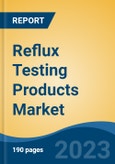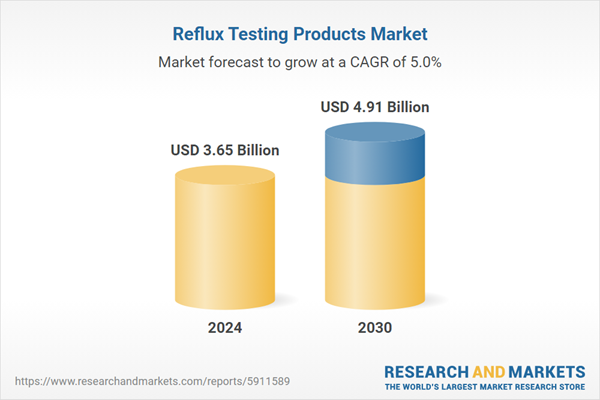Speak directly to the analyst to clarify any post sales queries you may have.
10% Free customizationThis report comes with 10% free customization, enabling you to add data that meets your specific business needs.
One of the key drivers of growth in the Global Reflux Testing Products Market is the increasing prevalence of GERD and related disorders worldwide. Factors such as unhealthy lifestyles, obesity, and dietary habits have contributed to a rising incidence of acid reflux, thereby fuelling the demand for accurate diagnostic tools. The aging population is prone to esophageal disorders, further boosting the market's expansion.
Technological advancements have played a pivotal role in shaping the landscape of reflux testing products. Innovations in sensor technology, wireless connectivity, and data analysis have enhanced the precision and convenience of diagnostic procedures, leading to improved patient outcomes and diagnostic accuracy. The shift towards minimally invasive diagnostic techniques has driven the adoption of advanced reflux testing products, offering patients a less invasive and more comfortable experience. In recent years, there has been a growing emphasis on the development of patient-centric diagnostic solutions, including home-based reflux testing kits, which are expected to create new opportunities in the market. Moreover, collaborations between medical device manufacturers and healthcare providers are likely to drive market growth by ensuring accessibility and affordability of reflux testing products.
Key Market Drivers
Rising Prevalence of gastroesophageal reflux disease (GERD)
The rising prevalence of gastroesophageal reflux disease (GERD) is a significant driver behind the growth of the Global Reflux Testing Products Market. GERD is a chronic digestive disorder characterized by the frequent and recurrent flow of stomach acid into the esophagus, leading to uncomfortable symptoms like heartburn, regurgitation, and chest pain. This condition has become increasingly common in recent years, affecting millions of individuals worldwide.Several factors contribute to the escalating prevalence of GERD. Unhealthy dietary habits, including the consumption of high-fat, spicy, and acidic foods, as well as excessive alcohol and caffeine intake, have been linked to the development of GERD. Furthermore, the global rise in obesity rates has added to the burden of GERD, as excess body weight can increase abdominal pressure, pushing stomach contents into the esophagus. According to Journal of Neurogastroenterology and Motility, GERD is a chronic and widespread condition.
A recent systematic review found its prevalence to range from 18.1% to 27.8% in North America, 8.8% to 25.9% in Europe, 2.5% to 7.8% in East Asia, 8.7% to 33.1% in the Middle East, 11.6% in Australia, and 23.0% in South America. The rising prevalence of GERD can be attributed to various factors, including older age, male gender, ethnicity, the use of analgesics, consumption of specific foods and beverages, a decrease in Helicobacter pylori infection rates, smoking, family history, high body mass index (BMI), and low physical activity levels. Many of these risk factors are closely tied to lifestyle choices.
Sedentary lifestyles and prolonged periods of sitting, often associated with modern working environments, can also contribute to GERD. Individuals spending long hours at desks or in front of screens may be more prone to experiencing acid reflux symptoms. As awareness of GERD and its potential complications has grown, more individuals are seeking medical attention and diagnosis. This surge in patient visits to healthcare professionals has driven the demand for reflux testing products. Accurate diagnosis is essential for proper management, as GERD can lead to serious complications, including Barrett's esophagus and esophageal cancer if left untreated.
In response to the increasing prevalence of GERD, the Global Reflux Testing Products Market has expanded to provide innovative and advanced diagnostic tools. These tools include pH monitoring systems, impedance-pH monitoring systems, and other cutting-edge devices designed to precisely assess and diagnose GERD. Additionally, the market has seen the development of patient-friendly, minimally invasive testing options, which encourage individuals to seek diagnosis and treatment.
Key Market Challenges
Cost Constraints
One of the primary factors contributing to cost constraints in the reflux testing products market is the high manufacturing costs associated with advanced diagnostic tools. Devices such as pH monitoring systems and impedance-pH monitoring systems are technologically sophisticated, requiring precision engineering and high-quality materials. The intricate sensors, data processing components, and wireless connectivity capabilities all contribute to elevated manufacturing expenses.Apart from initial manufacturing costs, the maintenance and calibration of reflux testing products can be expensive. These devices must undergo regular servicing and calibration to ensure their accuracy. Healthcare facilities that offer reflux testing services are burdened with the recurring cost of maintaining and updating their equipment, which, in turn, can lead to higher prices for patients.
The availability of comprehensive insurance coverage for reflux testing procedures varies widely across regions and healthcare plans. Many insurance providers do not fully cover the costs of reflux testing, leaving patients to bear a substantial portion of the financial burden. This lack of adequate insurance coverage can discourage individuals from pursuing reflux testing, particularly those with limited financial resources.
The cost constraints in the reflux testing products market have implications for the accessibility and affordability of these diagnostic tools. In regions with limited healthcare resources, including lower- and middle-income countries, the high cost of reflux testing products can significantly limit their availability. As a result, individuals in these areas may not have access to essential diagnostic services.
Key Market Trends
Shift Towards Minimally Invasive Techniques
The Global Reflux Testing Products Market has witnessed a significant boost due to the ongoing trend towards minimally invasive diagnostic techniques. Traditional methods for diagnosing gastroesophageal reflux disease (GERD), such as invasive endoscopy and barium swallow studies, often involve uncomfortable and invasive procedures that can discourage patients from seeking diagnosis and treatment. This has led to a growing preference among both healthcare providers and patients for less invasive and more patient-friendly alternatives, thereby fuelling the demand for reflux testing products.Minimally invasive reflux testing products, such as wireless pH monitoring systems and impedance-pH monitoring systems, have become increasingly popular due to their ability to provide accurate diagnostic data without the need for intrusive procedures. These devices offer patients a more comfortable experience, as they can be worn for extended periods without interfering with daily activities.
This patient-centric approach not only enhances patient acceptance but also encourages individuals to seek timely diagnosis and treatment for their GERD symptoms. In June 2022, Glenmark Pharmaceuticals Ltd completed the acquisition of approved generic versions of select over-the-counter medications from Wockhardt Ltd in the United States. This acquisition was executed through Glenmark Pharmaceuticals Inc., USA, a wholly owned subsidiary of the company. The acquired assets encompass approved abbreviated new drug applications (ANDAs), including famotidine tablets (10 mg and 20 mg), which are utilized for the treatment and prevention of stomach and intestinal ulcers, indigestion, heartburn, as well as Lansoprazole delayed-release capsules USP, 15 mg, among other pharmaceutical products.
Key Market Players
- Medtronic Plc
- Sierra Instruments, Inc.
- Respiratory Technology Corporation
- Ethicon, Inc.
- Medical Measurement Systems BV
- AstraZeneca Plc
- Diversatek, Inc.
- FLSmidth A/S
- Laborie Medical Technologies Corp.
- DRG Instruments GmbH
Report Scope:
In this report, the Global Reflux Testing Products Market has been segmented into the following categories, in addition to the industry trends which have also been detailed below:Reflux Testing Products Market, By Product Type:
- Catheter Based Testing Products
- Capsule Based Testing Products
- Reflux Testing Probes
- Other
Reflux Testing Products Market, By Disease Indication:
- Barrett's Esophagus
- Reflux Esophagitis
- Esophageal Adenocarcinoma
Reflux Testing Products Market, By End User:
- Hospitals &Clinics
- Ambulatory Surgical Centers
- Other
Global Reflux Testing Products Market, By Region:
- North America
- United States
- Canada
- Mexico
- Europe
- France
- United Kingdom
- Italy
- Germany
- Spain
- Asia-Pacific
- China
- India
- Japan
- Australia
- South Korea
- South America
- Brazil
- Argentina
- Colombia
- Middle East & Africa
- South Africa
- Saudi Arabia
- UAE
Competitive Landscape
Company Profiles: Detailed analysis of the major companies present in the Global Reflux Testing Products Market.Available Customizations:
With the given market data, the publisher offers customizations according to a company's specific needs. The following customization options are available for the report.Company Information
- Detailed analysis and profiling of additional market players (up to five).
This product will be delivered within 1-3 business days.
Table of Contents
Companies Mentioned
- Medtronic Plc
- Sierra Instruments, Inc.
- Respiratory Technology Corporation
- Ethicon, Inc.
- Medical Measurement Systems BV
- AstraZeneca Plc
- Diversatek, Inc.
- FLSmidth A/S
- Laborie Medical Technologies Corp.
- DRG Instruments GmbH
Table Information
| Report Attribute | Details |
|---|---|
| No. of Pages | 190 |
| Published | February 2025 |
| Forecast Period | 2024 - 2030 |
| Estimated Market Value ( USD | $ 3.65 Billion |
| Forecasted Market Value ( USD | $ 4.91 Billion |
| Compound Annual Growth Rate | 5.0% |
| Regions Covered | Global |
| No. of Companies Mentioned | 10 |









